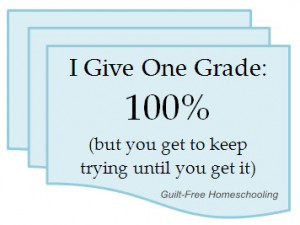We had pulled our children out of public school with my daughter starting fifth grade and my son beginning first grade. My daughter had been taught to “read” with this farce: when you come to a word you do not know, think of a word that begins with the same sound as the first letter of the unknown word, and if it fits in the sentence, it is probably right. Wrong. As I evaluated her reading ability, I realized she was guessing at more words than she was reading — and guessing incorrectly. She would use most of the letter-sounds in a word, but pronounce them in random order, a process which could lead the unsuspecting to cry “Dyslexia!” But I knew better. She was a very bright child who had grown slower and more despondent with each year of public schooling. She caught on to activities done at home with lightning speed, but the formal education lessons just did not take.
I had learned to read in first grade through a very thorough phonics program and was teaching my young son phonics as well, so I quickly recognized that my dear daughter had not had the benefit of learning to “sound out” entire words, even though she obviously knew the letter sounds. Her government school had pushed reading activities, using the read-as-many-books-as-possible-this-month rallies. Whenever that came along, my daughter would go back through the little children’s storybooks we owned, rereading them year after year, instead of pursuing new reading material. Reading familiar things was obviously much easier and more comfortable for her than the effort involved in tackling anything new.
Trying desperately not to bruise the psyche of this sensitive 10-year-old, I suggested that perhaps we needed to expand her reading capabilities by teaching her a new method for discovering how to read unknown words. Our supervising teacher that year was a close friend and (coincidentally) special education teacher who recommended her favorite remedial phonics system — a 2-week “crash course” in phonics for older students. (Ironic, isn’t it, that the “special ed” kids eventually get taught phonics, but the “normal” ones never do?) Although I knew my daughter’s capabilities well enough not to suspect learning disabilities, I knew she needed help — and fast, before she got discouraged with homeschooling and a mom who corrected her whenever she read a word incorrectly. It was a complete shock to me at that time that she had gone so many years in public school without anyone noticing that she was not reading at grade level (in 5th grade, she was accurately reading only the words for 2nd grade level). That revelation was the point when whatever faith I had left in free government education went swirling down the drain.
I bought the recommended book (Mary Pecci’s At Last! A Reading Method for Every Child), took my daughter through the 2-week crash course, and then thought “Now what?” Seeing she needed more practice to reinforce her newly learned skills, I grabbed my son’s phonics book for a guide and wrote my own remedial phonics practice sheets for fifth grade “beginning” phonics. I made up word games and puzzles to make the lessons fun and yet challenging. After I felt she had gained enough skill and confidence (and could actually read big new words), I challenged her to go back to one of the books she had “read” several times and read it again, this time sounding out the difficult words. I was confident that she would see the change in how many words she had guessed at before, but I was not prepared for her response: “Mom, you ruined this story! It’s a whole different book now!” However, her emotion was based more in surprise than anger, because she also realized how poor her reading skills had been. She also saw that her newfound ability to break a word into syllables and sound them out meant that no word in the world was too difficult for her now. We pulled long words out of the dictionary and chemical names from shampoo labels and she correctly read them all. Her desire to read Little Golden Books was quickly transferred to long chapter books, and the bookshelves in her bedroom grew heavy with her expanding collection of favorites.
Once reading was no longer a struggle, her schoolwork became a challenge for me as I was pressed to keep up with her, checking her work and reading over her assignments. During Christmas break of her 7th grade year, she calmly asked if I had ordered her 8th grade English book yet. Baffled as to why she would care nine months early, I said that no, of course I had not ordered next year’s book yet — why would she ask such a silly question? Her reply left me speechless: “Because I just finished the 7th grade book and I’m ready to start the next one.” I ordered the book.
She continued at that pace, to graduate from high school ten days before her 17th birthday — sixteen years old, with 7 credit hours at the community college in chemistry and English composition. She has now graduated from a 4-year college with a Bachelor of Arts in Business Administration — at age 20. Another day I will tell you about my son who just graduated from Homeschool High with 26 hours of college credits.




 Guilt-Free Homeschooling is the creation of Carolyn Morrison and her daughter, Jennifer Leonhard. After serious disappointments with public school, Carolyn spent the next 11 years homeschooling her two children, from elementary to high school graduation and college admission. Refusing to force new homeschooling families to re-invent the wheel, Carolyn and Jennifer now share their encouragement, support, tips, and tricks, filling their blog with "all the answers we were looking for as a new-to-homeschooling family" and making this website a valuable resource for parents, not just a daily journal. Guilt-Free Homeschooling -- Equipping Parents for Homeschooling Success!
Guilt-Free Homeschooling is the creation of Carolyn Morrison and her daughter, Jennifer Leonhard. After serious disappointments with public school, Carolyn spent the next 11 years homeschooling her two children, from elementary to high school graduation and college admission. Refusing to force new homeschooling families to re-invent the wheel, Carolyn and Jennifer now share their encouragement, support, tips, and tricks, filling their blog with "all the answers we were looking for as a new-to-homeschooling family" and making this website a valuable resource for parents, not just a daily journal. Guilt-Free Homeschooling -- Equipping Parents for Homeschooling Success!

Recent Comments